
- Usage in publication:
-
- Portage Lake lava series*
- Modifications:
-
- Named
- Dominant lithology:
-
- Basalt
- Andesite
- Sandstone
- Conglomerate
- AAPG geologic province:
-
- Wisconsin arch
Summary:
Named for Portage Lake, 10 mi south of Ahmeek quad., Houghton Co., northwestern MI (Upper Peninsula). Includes [and effectively abandons] rocks previously mapped as Eagle River, Ashbed, Central Mine, and Bohemian Range groups because these older subdivisions were arbitrary and depended on continuity of individual flows or beds for validity. Lavas range in composition from olivine basalt to andesite and are ophitic, glomeroporphyritic, porphyritic, or fine-grained equigranular in middle and lower portion, and amygdaloidal in upper portion. Contains beds of sandstone and conglomerate, containing mainly rhyolitic fragments, between flows. Subdivided into (ascending) St. Louis conglomerate, Copper City flow, Scales Creek flow, Old Colony sandstone, Wolverine sandstone, Kearsarge flow, Kingston conglomerate, Osceola flow, Calumet and Hecla conglomerate, Iroquois flow, Houghton conglomerate, Allouez conglomerate, Greenstone flow, Pewabic West conglomerate, Ashbed flow, and Hancock conglomerate. Columnar section indicates thickness of about 11,000 ft. Conformably underlies Copper Harbor conglomerate. Oldest rock in quadrangle area. Age is Precambrian (middle Keweenawan).
Source: GNU records (USGS DDS-6; Reston GNULEX).
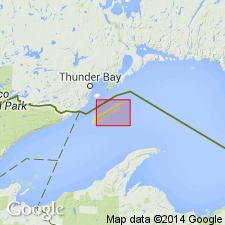
- Usage in publication:
-
- Portage Lake Volcanics*
- Modifications:
-
- Revised
- Overview
- AAPG geologic province:
-
- Wisconsin arch
Summary:
Name revised as Portage Lake Volcanics to bring the formation name into conformity with Code of Stratigraphic Nomenclature. This report subdivides the formation on Isle Royale, off the coast of Keweenaw Peninsula, MI, and correlates it with rest of Portage Lake Volcanics on mainland. Subdivisions of Portage Lake on Isle Royale include (ascending) Amygdaloid Island, Hill Point, Huginnin (formerly Huginnin Porphyrite), Minong (formerly Minong Trap), Grace Island, Greenstone (extended from Keweenaw Peninsula), Washington Island, Tobin Harbor, Long Island, Middle Point, Edwards Island, and Scoville Flows. Subdivisions on Keweenaw Peninsula are revised as (ascending): Baltic Conglomerate, St. Louis Conglomerate, Copper City Flow, Bohemia Conglomerate, Gratiot Flow, Scales Creek Flow, Minesota Conglomerate, Wolverine Sandstone, Kearsarge Flow, National Sandstone, Kingstone Conglomerate, Calumet and Hecla Conglomerate, Houghton Conglomerate, Allouez Conglomerate, Greenstone Flow, Pewabic West Conglomerate, and Hancock Conglomerate. Report includes detailed maps, charts, sections, and naming information for most subdivisions.
Source: GNU records (USGS DDS-6; Reston GNULEX).
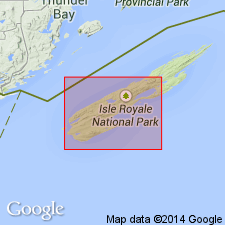
- Usage in publication:
-
- Portage Lake Volcanics*
- Modifications:
-
- Redescribed
- Dominant lithology:
-
- Volcanics
- Lava
- AAPG geologic province:
-
- Lake Superior region
Summary:
Redescribed from Portage Lake Lava Series to Portage Lake Volcanics in Isle Royale and vicinity, northern MI in the Lake Superior region. Is middle Keweenawan in age.
Source: GNU records (USGS DDS-6; Denver GNULEX).
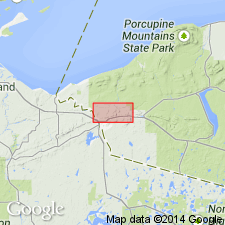
- Usage in publication:
-
- Portage Lake Volcanics*
- Modifications:
-
- Areal extent
- Overview
- AAPG geologic province:
-
- Wisconsin arch
Summary:
Portage Lake Volcanics extended from MI to WI, as shown in fig. 2, a map of westernmost MI and adjacent WI. Differs from underlying lower Keweenawan Kallander Creek Formation (new) in structural attitude, geographic distribution, residual magnetic polarity and orientation, metamorphic grade, and rock type. Relationship between the two formations is uncertain. A well-exposed section of Portage Lake Volcanics may be seen on Montreal River, where a nearly 400-ft thickness of rock occurs at top of Portage Lake.
Source: GNU records (USGS DDS-6; Reston GNULEX).
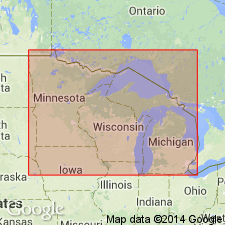
- Usage in publication:
-
- Portage Lake Volcanics
- Modifications:
-
- Geochronologic dating
- AAPG geologic province:
-
- Wisconsin arch
Summary:
U-Pb zircon dates yield an age of 1094+/-1.7 Ma for Greenstone Flow and 1096+/-1.9 Ma for Copper City Flow, both within Portage Lake Volcanics.
Source: GNU records (USGS DDS-6; Reston GNULEX).
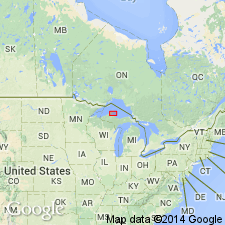
- Usage in publication:
-
- Portage Lake Volcanics
- Modifications:
-
- Geochronologic dating
- AAPG geologic province:
-
- Lake Superior region
Summary:
U-Pb dates on five zircon fractions within Greenstone Flow give an age of 1094.0 +/-1.5 Ma (100% probability of fit). Greenstone is a basaltic unit within upper part of Portage Lake. U-Pb dates on four zircon fractions within Copper City Flow give an age of 1096.2 +/-1.8 Ma (66% probability of fit). Copper City is a basaltic unit within lower part of Portage Lake. Study area is on Keweenawan Peninsula, MI, Lake Superior region. Underlies Copper Harbor Conglomerate.
Source: GNU records (USGS DDS-6; Denver GNULEX).
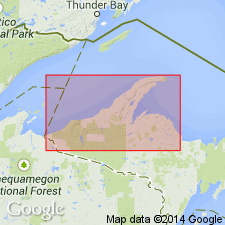
- Usage in publication:
-
- Portage Lake Volcanics*
- Modifications:
-
- Revised
- Geochronologic dating
- AAPG geologic province:
-
- Wisconsin arch
Summary:
Portage Lake Volcanics assigned to Bergland Group (new). Designation is consistent with usages of other workers who assign comparably thick volcanic successions to groups. Greenstone flow in upper part of formation has U-Pb zircon age of 1094.0+/-1.5 Ma (Davis and others, 1990, Earth and Planetary Science Letters, v. 97, p. 54-64). Report includes geologic map and correlation chart.
Source: GNU records (USGS DDS-6; Reston GNULEX).
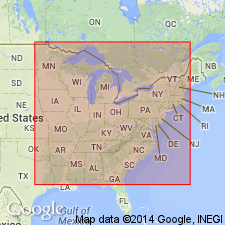
- Usage in publication:
-
- Portage Lake Volcanics*
- Modifications:
-
- Overview
- AAPG geologic province:
-
- Wisconsin arch
Summary:
On the correlation chart for Precambrian rocks of the conterminous United States, the Portage Lake Volcanics are shown in the Lake Superior Region as Middle Proterozoic (approximately 1100 Ma).
Source: GNU records (USGS DDS-6; Reston GNULEX).
For more information, please contact Nancy Stamm, Geologic Names Committee Secretary.
Asterisk (*) indicates published by U.S. Geological Survey authors.
"No current usage" (†) implies that a name has been abandoned or has fallen into disuse. Former usage and, if known, replacement name given in parentheses ( ).
Slash (/) indicates name conflicts with nomenclatural guidelines (CSN, 1933; ACSN, 1961, 1970; NACSN, 1983, 2005, 2021). May be explained within brackets ([ ]).

